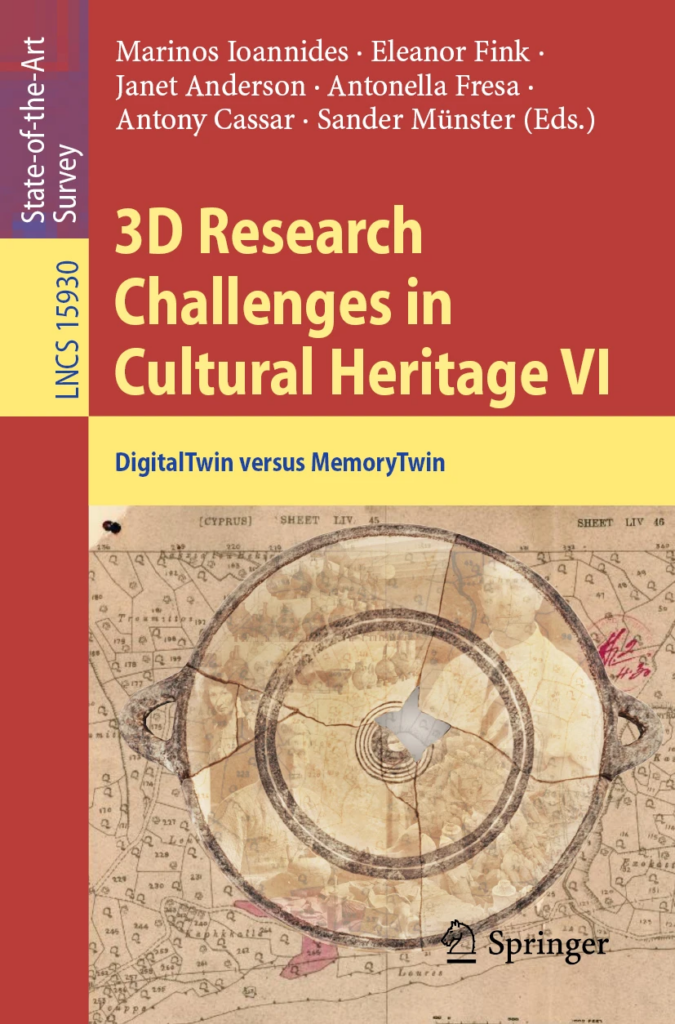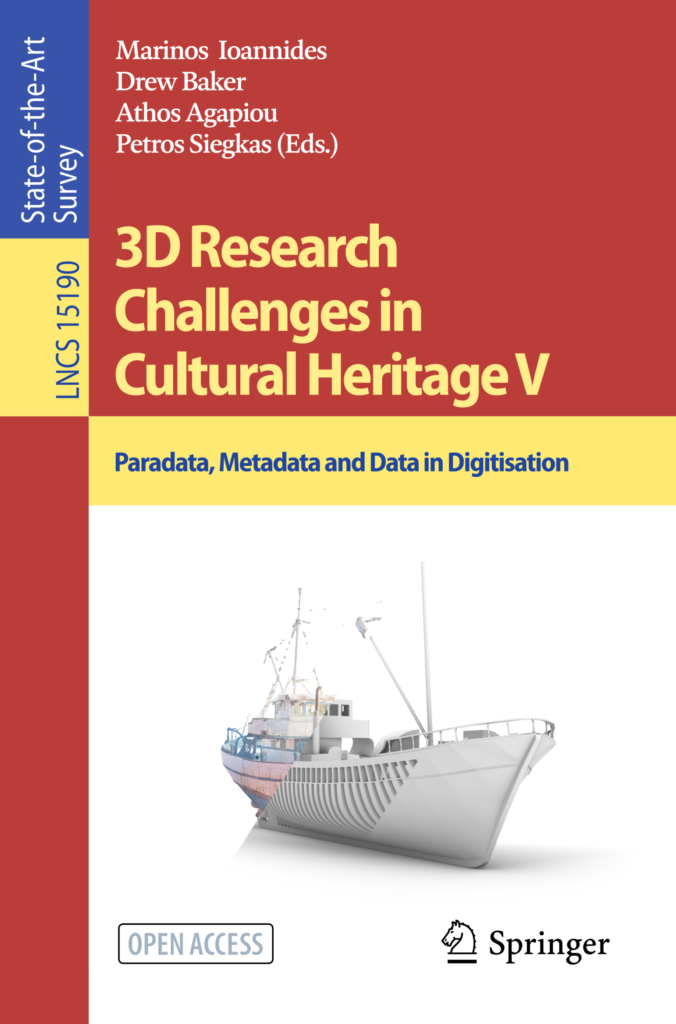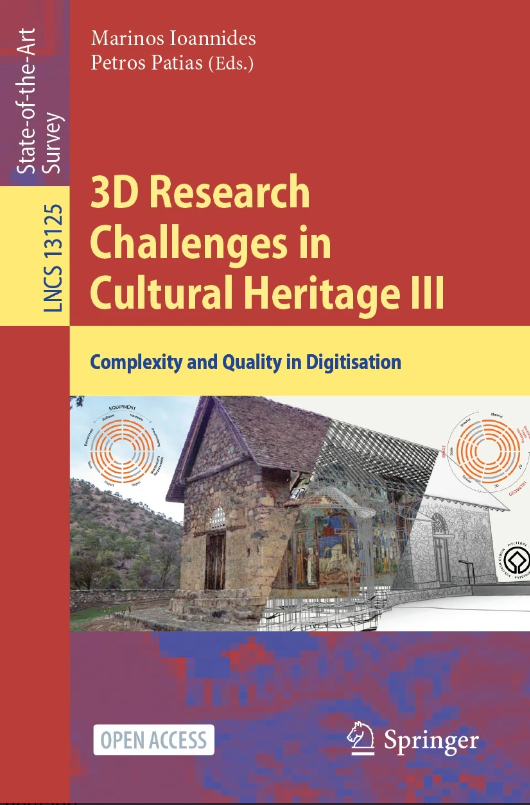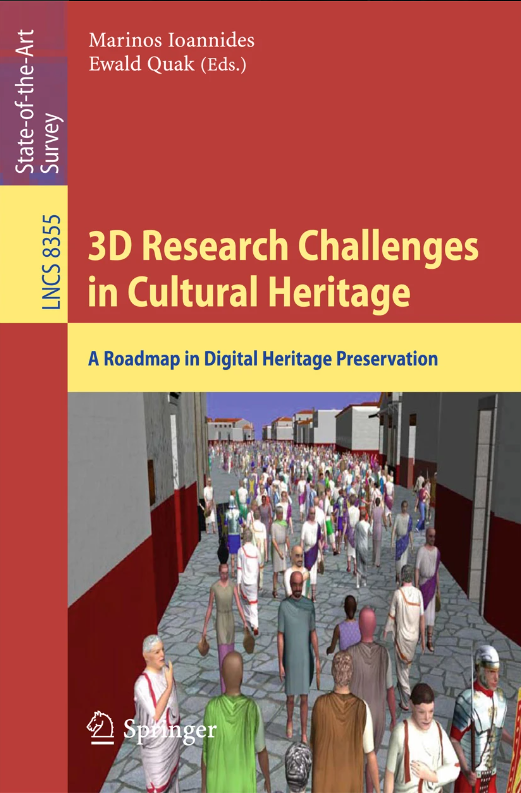Springer Nature: 3D Research Challenges in Cultural Heritage
Jump straight to our dedicated publications page on Springer!
3D Research Challenges in Cultural Heritage VI:
DigitalTwin versus MemoryTwin

This book presents a collection of papers focussing on 3D digitisation in the domain of cultural heritage. The use of data acquisition technologies in digitising cultural heritage holds great potential for preserving and disseminating the history of mankind. However, to exploit these opportunities in full, comprehensive guidelines for documenting the process of digitisation are required. Only then can the efficiency and credibility of digital representations be assured.
3D Research Challenges in Cultural Heritage V:
Paradata, Metadata and Data in Digitisation

Paradata is now widely seen, along with Metadata and geometrical data, as part of the trinity that indicates high-quality 3D digital resources, enriching 3D assets, creating knowledge and promoting reusability. However the Digital Cultural Heritage community still lacks a definitive description and differentiation of Paradata and Metadata, and their benefits to stakeholders, owners, the multidisciplinary DCH community, digital scholarship, and compliance with the European Commission Recommendation for the collection of 3D-digitised cultural heritage assets.
This publications draws from the spectrum of Digital Cultural Heritage practice professionals to share their experiences of using and working with Paradata seeking to lay down a common understanding of Paradata as a first step towards a community-built set of standards and expectations for its application to 3D documentation and the creation of knowledge.
3D Research Challenges in Cultural Heritage IV:
Risk Prevention and Monitoring Methods

This book will illustrate the advances and challenges in digital data acquisition/documentation of tangible objects and the modelling of acquired massive data sets into accurate 2D/3D architectural drawings/models through Heritage Building Information Modelling (HBIM), and parametric/freeform surfaces. Additionally, it will address the processes of semantic annotation of digital models and the application of linked data approaches to embedding vital data (original construction materials, conditions, structural analysis, books, research reports, storytelling, etc.) and enrich the model with ancillary records/models/data that inform the modern multidisciplinary team required to assess and protect heritage at risk.
3D Research Challenges in Cultural Heritage III:
Complexity and Quality in Digitisation

This open access book presents a collection of papers focusing on current 3D research challenges in the domain of digital cultural heritage. 3D technologies find considerable use within the field of cultural heritage at the beginning of the 21st century, for example in the areas of data acquisition, modeling, archiving in local repositories, harvesting in digital libraries and their long-term preservation.
This volume put emphasis on a number of challenges facing 3D research in the 2D/3D digitization of tangible objects and their transformation to digital/virtual/memory twins; the interplay of geometry, semantics and the recovery and management of knowledge in digital cultural heritage; the handling of 3D data via the Cloud on the Internet and mobile devices; the presentation of cultural heritage content in 3D to the general public; and the 3D reproduction of cultural heritage objects from virtual to real.
3D Research Challenges in Cultural Heritage II:
How to Manage Data and Knowledge Related to Interpretative Digital 3D Reconstructions of Cultural Heritage

This book reflects a current state of the art and future perspectives of Digital Heritage focusing on not interpretative reconstruction and including as well as bridging practical and theoretical perspectives, strategies and approaches. Comprehensive key challenges are related to knowledge transfer and management as well as data handling within a interpretative digital reconstruction of Cultural Heritage including aspects of digital object creation, sustainability, accessibility, documentation, presentation, preservation and more general scientific compatibility.
The three parts of the book provide an overview of a scope of usage scenarios, a current state of infrastructures as digital libraries, information repositories for an interpretative reconstruction of Cultural Heritage; highlight strategies, practices and principles currently used to ensure compatibility, reusability and sustainability of data objects and related knowledge within a 3D reconstruction work process on a day today work basis; and show innovative concepts for the exchange, publishing and management of 3D objects and for inherit knowledge about data, workflows and semantic structures.
3D Research Challenges in Cultural Heritage:
A Roadmap in Digital Heritage Preservation

This book contains selected contributions from some of the most renowned researchers in the field of Digital Heritage and 3D representation of the Past, based in large part on invited presentations from the workshop “Computational Geometry and Ontologies for Cultural Heritage 3D Digital Libraries: What are the future alternatives for Europeana?” which was held in conjunction with the International Conference on Cultural Heritage EuroMed2012 on the island of Cyprus in October 2012.
This was the official event of the Cyprus Presidency of the Council of the European Union on Progress in Cultural Heritage Preservation. The aim of this book is to provide an insight to ongoing research and future directions in this novel, continuously very promising and multi-disciplinary evolving field, which lies at the intersection of digital heritage, engineering, computer science, mathematics, material science, architecture, civil engineering and archaeology.
Click HERE to take you to the Springer Series webpage


